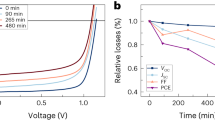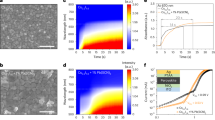Abstract
Organic–inorganic metal halide perovskites have demonstrated high power conversion efficiencies in solar cells and promising performance in a wide range of optoelectronic devices. The existence and stability of bound electron–hole pairs in these materials and their role in the operation of devices with different architectures remains a controversial issue. Here we demonstrate, through a combination of optical spectroscopy and multiscale modelling as a function of the degree of polycrystallinity and temperature, that the electron–hole interaction is sensitive to the microstructure of the material. The long-range order is disrupted by polycrystalline disorder and the variations in electrostatic potential found for smaller crystals suppress exciton formation, while larger crystals of the same composition demonstrate an unambiguous excitonic state. We conclude that fabrication procedures and morphology strongly influence perovskite behaviour, with both free carrier and excitonic regimes possible, with strong implications for optoelectronic devices.
This is a preview of subscription content, access via your institution
Access options
Subscribe to this journal
Receive 12 print issues and online access
$209.00 per year
only $17.42 per issue
Buy this article
- Purchase on Springer Link
- Instant access to full article PDF
Prices may be subject to local taxes which are calculated during checkout




Similar content being viewed by others
References
Zhou, H. et al. Interface engineering of highly efficient perovskite solar cells. Science 345, 542–546 (2014).
Jeon, N. J. et al. Compositional engineering of perovskite materials for high-performance solar cells. Nature 517, 476–480 (2015).
Xing, G., Mathews, N., Lim, S. & Yantara, N. Low-temperature solution-processed wavelength-tunable perovskites for lasing. Nature Mater. 13, 476–480 (2014).
Deschler, F. et al. High photoluminescence efficiency and optically pumped lasing in solution-processed mixed halide perovskite semiconductors. J. Phys. Chem. Lett. 5, 1421–1426 (2014).
Zhu, H. et al. Lead halide perovskite nanowire lasers with low lasing thresholds and high quality factors. Nature Mater. 14, 636–642 (2015).
Tan, Z.-K. et al. Bright light-emitting diodes based on organometal halide perovskite. Nature Nanotech. 9, 687–692 (2014).
Ball, J. M., Lee, M. M., Hey, A. & Snaith, H. J. Low-temperature processed meso-superstructured to thin-film perovskite solar cells. Energy Environ. Sci. 6, 1739–1743 (2013).
De Bastiani, M., D'Innocenzo, V., Stranks, S. D., Snaith, H. J. & Petrozza, A. Role of the crystallization substrate on the photoluminescence properties of organo-lead mixed halides perovskites. APL Mater. 2, 081509 (2014).
Grancini, G. et al. The impact of the crystallization processes on the structural and optical properties of hybrid perovskite films for photovoltaics. J. Phys. Chem. Lett. 5, 3836–3842 (2014).
Marchioro, A. et al. Unravelling the mechanism of photoinduced charge transfer processes in lead iodide perovskite solar cells. Nature Photon. 8, 250–255 (2014).
Manser, J. S. & Kamat, P. V. Band filling with free charge carriers in organometal halide perovskites. Nature Photon. 8, 737–743 (2014).
D'Innocenzo, V. et al. Excitons versus free charges in organo-lead tri-halide perovskites. Nature Commun. 5, 3486 (2014).
D'Innocenzo, V., Srimath Kandada, A. R., De Bastiani, M., Gandini, M. & Petrozza, A. Tuning the light emission properties by band gap engineering in hybrid lead-halide perovskite. J. Am. Chem. Soc. 136, 17730–17733 (2014).
Lin, Q., Armin, A., Nagiri, R. C. R., Burn, P. L. & Meredith, P. Electro-optics of perovskite solar cells. Nature Photon. 9, 106–112 (2014).
Saba, M. et al. Correlated electron–hole plasma in organometal perovskites. Nature Commun. 5, 5049 (2014).
Miyata, A. et al. Direct measurement of the exciton binding energy and effective masses for charge carriers in an organic–inorganic tri-halide perovskite. Nature Phys. 11, 582–587 (2015).
Shi, D. et al. Low trap-state density and long carrier diffusion in organolead trihalide perovskite single crystals. Science 347, 519–522 (2015).
Dong, Q. et al. Electron–hole diffusion lengths >175 μm in solution-grown CH3NH3PbI3 single crystals. Science 347, 967–970 (2015).
Nie, W. et al. High-efficiency solution-processed perovskite solar cells with millimeter-scale grains. Science 347, 522–525 (2015).
Im, J.-H., Jang, I.-H., Pellet, N., Grätzel, M. & Park, N.-G. Growth of CH3NH3PbI3 cuboids with controlled size for high-efficiency perovskite solar cells. Nature Nanotech. 9, 927–932 (2014).
Xing, G. et al. Long-range balanced electron- and hole-transport lengths in organic–inorganic CH3NH3PbI3 . Science 342, 344–347 (2013).
Varshni, Y. P. Temperature dependence of the energy gap in semiconductors. Physica 34, 149–154 (1967).
Onoda-Yamamuro, N., Matsuo, T. & Suga, H. Calorimetric and IR spectroscopic studies of phase transitions in methylammonium trihalogenoplumbates (II). J. Phys. Chem. Solids 51, 1383–1395 (1990).
Shimizu, M., Fujisawa, J.-I. & Ishi-Hayase, J. Influence of dielectric confinement on excitonic nonlinearity in inorganic–organic layered semiconductors. Phys. Rev. B 71, 205306 (2005).
Hulin, D. et al. Well-size dependence of exciton blue shift in GaAs multiple-quantum-well structures. Phys. Rev. B 33, 4389–4391 (1986).
Peyghambarian, N. et al. Blue shift of the exciton resonance due to exciton–exciton interactions in a multiple-quantum-well structure. Phys. Rev. Lett. 53, 2433–2436 (1984).
Schmitt-Rink, S., Chemla, D. & Miller, D. Theory of transient excitonic optical nonlinearities in semiconductor quantum-well structures. Phys. Rev. B 32, 6601–6609 (1985).
Wu, X., Trinh, M. T. & Zhu, X. Excitonic many-body interactions in two-dimensional lead iodide perovskite quantum wells. J. Phys. Chem. C 119, 14714–14721 (2015).
Quarti, C., Grancini, G. & Mosconi, E. The raman spectrum of the CH3NH3PbI3 hybrid perovskite: interplay of theory and experiment. J. Phys. Chem. Lett. 5, 279–284 (2014).
Even, J. et al. Solid-state physics perspective on hybrid perovskite semiconductors. J. Phys. Chem. C 119, 10161–10177 (2015).
Heo, J. H., Song, D. H. & Im, S. H. Planar CH3NH3PbBr3 hybrid solar cells with 10.4% power conversion efficiency, fabricated by controlled crystallization in the spin-coating process. Adv. Mater. 26, 8179–8183 (2014).
Edri, E., Kirmayer, S., Cahen, D. & Hodes, G. High open-circuit voltage solar cells based on organic–inorganic lead bromide perovskite. J. Phys. Chem. Lett. 4, 897–902 (2013).
Tanaka, K. et al. Comparative study on the excitons in lead-halide-based perovskite-type crystals CH3NH3PbBr3CH3NH3PbI3 . Solid State Commun. 127, 619–623 (2003).
Hoke, E. T. et al. Reversible photo-induced trap formation in mixed-halide hybrid perovskites for photovoltaics. Chem. Sci. 6, 613–617 (2014).
Sadhanala, A. & Deschler, F. Preparation of single-phase films of CH3NH3Pb(I1–xBrx)3 with sharp optical band edges. J. Phys. Chem. Lett. 5, 2501–2505 (2014).
Mosconi, E., Quarti, C., Ivanovska, T., Ruani, G. & De Angelis, F. Structural and electronic properties of organo-halide lead perovskites: a combined IR-spectroscopy and ab initio molecular dynamics investigation. Phys. Chem. Chem. Phys. 16, 16137–16144 (2014).
Wasylishen, R., Knop, O. & Macdonald, J. Cation rotation in methylammonium lead halides. Solid State Commun. 56, 581–582 (1985).
Poglitsch, A. & Weber, D. Dynamic disorder in methylammoniumtrihalogenoplumbates (II) observed by millimeter-wave spectroscopy. J. Chem. Phys. 87, 6373 (1987).
Frost, J. M., Butler, K. T. & Walsh, A. Molecular ferroelectric contributions to anomalous hysteresis in hybrid perovskite solar cells. APL Mater. 2, 081506 (2014).
Acknowledgements
The research leading to these results has received funding from the European Union Seventh Framework Programme (FP7/2007-2013) under grant agreement no. 604032 of the MESO project, under grant agreement 316494 (DESTINY), the EU Horizon 2020 Research and Innovation Programme under grant agreement no. 643238 (SYNCHRONICS) and from Fondazione Cariplo (project GREENS no. 2013-0656). J.M.F. is funded by the EPSRC (EP/K016288/ and EP/M009580/1), and A.W. is supported by the European Research Council (project no. 277757). The authors thank S. Neutzner for help with fs-TA experiments and W. Xu for help with sample preparation. The authors thank E.T. Hoke, E.R. Dohner and H. Karunadasa for discussions and for providing the single crystal. The authors thank L. Manna for discussions and access to the XRD facility.
Author information
Authors and Affiliations
Contributions
G.G., A.R.S.K. and A.J.B. performed the transient absorption measurements. M.G. and M.D.B. prepared the samples and characterized them by SEM. S.M. performed XRD and SEM characterization. G.G., A.R.S.K., G.L. and A.P. analysed the optical spectroscopy data. J.M.F. and A.W. performed the multiscale modelling and analysed the results. The manuscript was written with contributions from all authors. A.P. supervised the project.
Corresponding author
Ethics declarations
Competing interests
The authors declare no competing financial interests.
Supplementary information
Supplementary information
Supplementary information (PDF 1747 kb)
Rights and permissions
About this article
Cite this article
Grancini, G., Srimath Kandada, A., Frost, J. et al. Role of microstructure in the electron–hole interaction of hybrid lead halide perovskites. Nature Photon 9, 695–701 (2015). https://doi.org/10.1038/nphoton.2015.151
Received:
Accepted:
Published:
Issue Date:
DOI: https://doi.org/10.1038/nphoton.2015.151
This article is cited by
-
Anisotropic carrier dynamics and laser-fabricated luminescent patterns on oriented single-crystal perovskite wafers
Nature Communications (2024)
-
Mahan excitons in room-temperature methylammonium lead bromide perovskites
Nature Communications (2020)
-
Triplet management for efficient perovskite light-emitting diodes
Nature Photonics (2020)
-
Indirect tail states formation by thermal-induced polar fluctuations in halide perovskites
Nature Communications (2019)
-
Phonon coherences reveal the polaronic character of excitons in two-dimensional lead halide perovskites
Nature Materials (2019)



